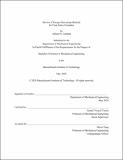| dc.contributor.advisor | Kamal Youcef-Toumi. | en_US |
| dc.contributor.author | Lenhard, Allison N. | en_US |
| dc.contributor.other | Massachusetts Institute of Technology. Department of Mechanical Engineering. | en_US |
| dc.date.accessioned | 2020-10-08T21:30:32Z | |
| dc.date.available | 2020-10-08T21:30:32Z | |
| dc.date.copyright | 2020 | en_US |
| dc.date.issued | 2020 | en_US |
| dc.identifier.uri | https://hdl.handle.net/1721.1/127922 | |
| dc.description | Thesis: S.B., Massachusetts Institute of Technology, Department of Mechanical Engineering, May, 2020 | en_US |
| dc.description | Cataloged from the official PDF of thesis. | en_US |
| dc.description | Includes bibliographical references (pages 44-48). | en_US |
| dc.description.abstract | Energy harvesting is the process of accumulating and storing energy from residual sources for use in powering electronic devices. Low-power energy harvesting technologies typically utilize either mechanical, thermal, radiation, flow-based, or bio-chemical energy sources. Research in low-power energy harvesting technologies is motivated by an increased interest in the Internet of Things and the need to create isolated electronic systems, such as wireless sensor networks for system monitoring. Twin screw extruders are a type of extrusion processing machinery and could benefit from a condition monitoring system. Implementing a condition monitoring system for a twin screw extruder can prevent wasting materials, producing unusable products, and working extensively on machine maintenance. However, it becomes difficult to integrate a condition monitoring system into the machinery because of the lack of accessibility. Condition monitoring would have to occur in the process section of the twin screw extruder, but the nature of the process section makes it difficult to implement a traditionally wired and powered condition monitoring system. A condition monitoring system powered by energy harvesting techniques would be ideal for a twin screw extruder. The shaft mechanical vibrations, high temperature thermal dissipation, and polymer fluid dynamics present in a twin screw extruder can potentially be used in an energy harvesting system. After a literature review, mechanical vibrations and temperature gradients were regarded as the best potential energy harvesting drivers. Based on preliminary analysis of the system, vibrational energy harvesting is predicted to produce between 3.35-16.75 mW of power, while thermally driven energy harvesting is expected to produce between 8-15 mW of power. The estimated power output would be significant enough to power a low-power consumption strain sensor and has the potential to power other sensors as well. | en_US |
| dc.description.statementofresponsibility | by Allison N. Lenhard. | en_US |
| dc.format.extent | 48 pages | en_US |
| dc.language.iso | eng | en_US |
| dc.publisher | Massachusetts Institute of Technology | en_US |
| dc.rights | MIT theses may be protected by copyright. Please reuse MIT thesis content according to the MIT Libraries Permissions Policy, which is available through the URL provided. | en_US |
| dc.rights.uri | http://dspace.mit.edu/handle/1721.1/7582 | en_US |
| dc.subject | Mechanical Engineering. | en_US |
| dc.title | Review of energy harvesting methods for twin screw extruders | en_US |
| dc.type | Thesis | en_US |
| dc.description.degree | S.B. | en_US |
| dc.contributor.department | Massachusetts Institute of Technology. Department of Mechanical Engineering | en_US |
| dc.identifier.oclc | 1197973249 | en_US |
| dc.description.collection | S.B. Massachusetts Institute of Technology, Department of Mechanical Engineering | en_US |
| dspace.imported | 2020-10-08T21:30:31Z | en_US |
| mit.thesis.degree | Bachelor | en_US |
| mit.thesis.department | MechE | en_US |
